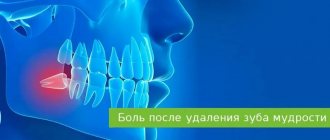Author: Trofimov Andrey Yurievich
What to do after tooth extraction? Every person has gone through this procedure in their life. Doctors always give recommendations, but more often than not, after the pain relief wears off, every second patient forgets about what was told to him in the dental chair. In most cases, after the anesthesia wears off, the pain returns with a vengeance. What should you do if after tooth extraction there is bleeding, the socket, gums become inflamed, or swelling occurs? How to avoid infection and a repeat unpleasant trip to the dentist?
General recommendations
Important restrictions after tooth extraction
Taking medications after tooth extraction
What else should you do after tooth extraction?
Hygiene rules after tooth extraction
What is normal after tooth extraction?
General recommendations
The most important rule in such a sensitive issue will be timely assistance from a qualified specialist. Therefore, if your tooth suddenly starts to hurt badly, this is not a reason to just take a pill and forget about this unpleasant moment, this is a good reason to go to a dental clinic, where you will be given first aid.
With any removal, complex or ordinary, there are a number of rules that must be followed to speed up the healing of the wound, as well as avoid abscesses and other negative consequences.
- Removing the gauze compress. The doctor leaves cotton wool or gauze after tooth extraction. A maximum of one hour after arriving from the dentist, you must carefully remove the protective swab. If it has dried out and stuck to the gum, do not remove it until you soak the area with chlorhexidine, since careless movement can damage or even remove the clot hiding the wound.
- Pain relief. Any discomfort after tooth extraction is a normal process for which you need to be prepared. Ice or any cool item from the refrigerator will help relieve discomfort. The selected item is wrapped in a towel and applied to the sore cheek. In addition to relieving pain, this action will help reduce the chances of swelling. However, this action also has its limitations: ice can be applied several times, making sure to take a break of 5-7 minutes.
- Eating. In the first few hours after tooth extraction, be it a molar or a chewing tooth, you should not eat any food, even if you are very hungry. Over the next 24 hours, the temperature of the food should only be at room temperature. Food should not be too spicy or salty, this can cause additional irritation of the mucous membrane.
- Limit alcohol and smoking. On the first day after tooth extraction, you should refrain from drinking alcoholic beverages. Even a small dose of alcohol can cause blood vessels to dilate, which will ultimately lead to bleeding from the wound. Smoking is permissible, but again at least 2-3 hours after the operation.
- Applying and removing sutures. If sutures were placed at the dental clinic after tooth extraction, the patient is usually invited for a follow-up appointment in a week. In some cases, the sutures dissolve on their own within two weeks.
- Dental treatment. For those who are now closely involved in treating the entire oral cavity, a reasonable question arises: when can the procedures be continued? If the removal was not difficult, then it will be possible to resume meetings with your doctor after 7 days.
Causes of pain after removal
The severity of pain depends on the complexity of the operation performed. Normally, pain may occur immediately after the anesthetic wears off, and discomfort may persist for 2-3 days. Then the symptom should subside. Sometimes dentists allow pain to persist for five days, but in the absence of other complaints.
The main cause of pain in the socket area after wisdom tooth removal is alveolitis. Inflammation of the socket develops for the following reasons:
- Highly traumatic surgical procedure.
- Incomplete sanitation of the hole, preservation of tooth fragments in it.
- Injuries to the mucous membrane during surgery, for example, with a bur when dividing roots or with forceps when applying cheeks to the walls of a tooth.
- Refusal to apply sutures if there are direct indications for the procedure.
- No course of antibiotics after complex tooth extraction.
Characteristic will be an increase in pain and the addition of other signs of inflammation. The only right decision in this situation is to visit the dentist.
Important restrictions after tooth extraction
Each patient, in addition to recommendations, should also know what not to do:
- Visit the bathhouse, sauna or swimming pools. Experts also recommend limiting yourself to a short period of time by taking a shower rather than a hot bath.
- Go to the gym and take on heavy physical activity;
- Experiencing stress, which, oddly enough, can seriously affect the wound and even contribute to the opening of bleeding;
- Get into the mouth, in the wound area with dirty hands;
- Touch the site of tooth extraction, be it the tongue or fingers, because this will certainly lead to damage to the clot;
- Brush the removal area with a toothbrush;
- Actively rinse your mouth, because any aggressive external actions can lead to clot disruption and the development of alveolitis.
It is worth noting that representatives of the fair half of humanity are not recommended to remove teeth during the menstrual cycle, because this will only provoke bleeding from the resulting wound.
Causes of swelling after removal
Swelling of the mucous membrane in the area of removal in the gum area, as well as swelling of the cheeks, are also considered normal after wisdom tooth extraction. This is explained by tissue injury and the body’s natural reaction to the procedure. Normally, swelling increases the next day after visiting a dental surgeon, but then, if all recommendations are followed, it should subside.
If the swelling continues to increase, you should consult a doctor. The same applies to situations where, in addition to tissue swelling, there is increased pain, discharge from the socket, and increased body temperature. The listed signs indicate inflammation, which requires initiation of treatment.
The signs will be especially pronounced if there was already purulent inflammation at the time of visiting the dentist. In this case, even a correctly performed procedure, creating an outflow of inflammatory exudate, does not exclude an increase in tissue edema. When removing the upper tooth, swelling may spread to the orbital area. During surgery on the third molar of the mandible, swelling may extend to the neck and ear area. If after a day the symptom becomes less pronounced, we can assume that there are no complications.
In addition to increased swelling and pain, the following signs will be an indication for an emergency visit to the dentist:
- Discharge of pus from the socket.
- Bleeding.
- Pain when swallowing.
- Pain when trying to open your mouth.
- Swelling of the face, accompanied by redness of the skin.
It is unlikely that tissue swelling will be completely avoided, but the risk of complications can be reduced. It is enough to follow the doctor’s instructions, take prescribed medications and monitor oral hygiene.
Taking medications after tooth extraction
Experienced specialists recommend taking antihistamines. They will help avoid swelling of the cheeks, because in addition to working on allergic reactions, antihistamines also have an anti-edematous effect.
You should not overdo it with medications if the pain is tolerable and tooth extraction was a procedure of ordinary complexity. A little trick that can be remembered for the future is to take an analgesic even before the patient stops feeling the anesthesia administered by the doctor.
As for antibiotics, it is strictly not recommended to take them without a corresponding prescription from the attending physician. In what cases does the surgeon issue a referral for the purchase of necessary medications:
- for difficult removal;
- with the development of the inflammatory process;
- in case of concomitant diseases such as stomatitis or candidiasis.
Why there is bad breath and what to do
The appearance of an unpleasant odor after the removal of a wisdom tooth indicates the development of an inflammatory process. In most cases, the symptom appears 3-4 days after surgery and is accompanied by tissue swelling and pain. In this case, you need to consult a doctor.
Odor may also develop due to lack of hygiene. This increases the risk of inflammatory abs, so you shouldn’t forget about brushing your teeth.
It is worth considering that some medications that doctors use to protect the socket may have a specific odor. As a rule, dentists warn the patient about this situation immediately after the procedure.
Removing a wisdom tooth is a complex procedure, but following all the dentist’s recommendations will help reduce the risk of complications to zero. Our doctors always tell patients in detail the features of the postoperative period and prescribe all prescriptions, including antibiotics and analgesics. All they have to do is follow all the instructions exactly.
Hygiene rules after tooth extraction
The first and important rule will be to limit brushing and rinsing your teeth immediately after surgery. You can start your usual lifestyle with daily brushing of your teeth the next day.
It is worth purchasing a brush with soft bristles at a pharmacy or store in advance, but it is still necessary to clean the area of removal with special care. Irrigator and dental floss are not allowed.
Hole hygiene deserves special attention. Dental surgeons recommend the following method for care:
- take a herbal decoction or a special rinse purchased at the pharmacy into the oral cavity;
- hold it in your mouth for several minutes, without performing any additional actions such as rolling water;
- After cleansing, you should try to refrain from drinking water and food for a couple of hours.
This action will help to avoid inflammatory processes in and around the hole, and will also reduce bleeding. Baths based on an antiseptic, for example, water-based chlorhexidine or furatsilin, will be effective.
Tooth extraction itself is an unpleasant procedure. And if complications arise, such as alveolitis, then the patient’s mood deteriorates even more. In order to prevent its occurrence, you need to know everything about this unpleasant disease. We will tell you what you need to know about the causes of alveolitis, its types, first symptoms and treatment methods.
What it is
Alveolitis of the tooth socket is an inflammatory disease that occurs after tooth extraction as a result of infection of the wound. If the operation was difficult, with injury to the gums and the tooth socket itself, then the risk of complications increases significantly. Normally, the hole after tooth extraction heals within one to two weeks, but with alveolitis this process takes a long time.
Since the disease occurs when an infection enters the wound, in order to prevent complications from occurring, it is necessary to carefully monitor oral hygiene after the tooth extraction procedure.
Alveolitis can occur before the tooth extraction procedure as a result of infection.
Causes
Alveolitis of the socket most often occurs after tooth extraction and is considered its main complication. However, it does not always occur. In order for this complication to arise, a confluence of certain circumstances is necessary.
The main causes of alveolitis are:
- destruction of the blood clot that forms after tooth extraction and prevents infection from entering the wound;
- getting plaque, stone, or bone fragments into the hole during removal;
- unscrupulous cleansing of the hole by a doctor from granulomas and granulations;
- violation of sterility during surgery;
- too traumatic removal;
- failure on the part of the patient to comply with all the doctor’s instructions;
- reduced immunity and exhaustion of the patient’s body.
After tooth extraction, you should not rinse your mouth too vigorously, as you can wash out the formed blood clot from the hole; this threatens the entry of pathogenic microbes into the wound, which cause inflammation.
Symptoms
The first signs of alveolitis usually appear 2-3 days after the procedure. The symptoms of the disease cannot be confused with anything. This is, first of all:
- severe pain in the area of the extracted tooth;
- constant intensification and spread of pain to adjacent areas of the oral cavity;
- fever up to 38.5° C, chills and general deterioration of health;
- the appearance of bad breath;
- inflammation, swelling and redness of the gums;
- absence of blood clot;
- the presence of a specific gray plaque;
- enlargement of the submandibular lymph nodes;
- presence of purulent exudate.
If one or more symptoms of the disease appear, you must immediately consult a dentist, since alveolitis does not go away on its own, it must be treated as soon as possible. Otherwise, complications are possible.
Diagnostics
The diagnosis of “alveolitis” can only be made by a doctor after a thorough examination of the patient’s oral cavity. Do not self-diagnose under any circumstances! This is a serious disease that, without proper treatment, can cause more dangerous complications, including blood poisoning. The absence of a blood clot in the socket at the site of the extracted tooth in the presence of other symptoms of the disease is decisive when making a diagnosis.
Treatment
If treatment for alveolitis is started in time, the disease usually goes away within a few days. Treatment usually consists of the following:
- thorough removal under local anesthesia of the remaining blood clot at the site of the extracted tooth;
- treating the walls of the socket with a dental instrument until slight bleeding appears;
- further treatment with a special antiseptic raster to prevent the spread of infection;
- the use of antibiotics (usually in the form of a powder that is sprinkled on the hole);
- prescription of painkillers;
- rinsing the mouth with antiseptic solutions;
- physiotherapeutic procedures aimed at speedy healing of the wound.
One of the most common complications of alveolitis, if not treated promptly, is osteomyelitis of the jaw bone. To prevent its occurrence, you should immediately consult a doctor as soon as you suspect some signs of alveolitis.
If you do not have the opportunity to see a dentist immediately, before visiting a doctor you should rinse your mouth with a warm (but not hot!) 3% solution of hydrogen peroxide or baking soda (half a teaspoon of soda per glass of boiled water).
Medicines
After thoroughly treating the hole, the doctor usually prescribes special medications to the patient for the treatment of alveolitis. In addition to antibiotics and painkillers, antiseptic solutions for oral baths and mouth rinses are necessarily prescribed, because maintaining the cleanliness of the mouth and socket is an indispensable condition for successful treatment.
The following drugs are most effective:
- Hexicon . A modern antiseptic drug that is successfully used in dentistry. Particularly effective for stomatitis, gingivitis, periodontitis, alveolitis. Intended for topical use. Hexicon solution is used both in the form of applications and in the form of oral baths or for rinsing the mouth.
- Corsodil . The active substance of the drug is chlorhexidine. This is an effective antiseptic that has a bactericidal effect. Used in dentistry to disinfect the oral cavity. Used externally, as a solution for rinsing, irrigation and applications. After cleaning the socket of an extracted tooth, systematically rinsing the mouth with Corsodil solution has a good effect.
- Stomatidin . An effective antiseptic with antifungal and antibacterial spectrum, which is used not only in dentistry, but also in ENT practice. It prevents the development of infections and is indicated for stomatitis, gingivitis, alveolitis, periodontal disease, tonsillitis and pharyngitis. It is used both for rinsing the mouth and for applications.
- Chlorhexidine . A proven broad-spectrum antiseptic drug that is used for disinfection not only in dentistry. Effective for treating purulent wounds, in the treatment of diseases of the oral mucosa. It is an excellent preventative against most dental diseases.
- Eludril . Created on the basis of chlorhexidine. It has analgesic, anti-inflammatory and antiseptic effects. Indicated for stomatitis, gingivitis, alveolitis, periodontitis, as well as for treating the oral cavity before and after tooth extraction.
Prevention
The best prevention is the patient's strict compliance with all doctor's instructions. After tooth extraction, you should not rinse your mouth too aggressively to avoid damaging the blood clot. After all, its presence in the socket is a guarantee that pathogenic bacteria that provoke inflammation of the socket or alveolitis will not get into the wound.
When to see a doctor?
If the swelling increases over the course of a week and does not subside, you should make an appointment with your dentist. You should also consult a doctor if the following symptoms appear:
- temperature rise to 38-39 degrees,
- putrid odor from the mouth,
- increasing pain,
- difficulty opening the mouth,
- swelling of the eyes, neck and other places.
These signs indicate the development of serious complications. This could be gumboil, alveolitis, or dental cyst. A dentist will help determine the exact cause. Do not delay your visit to a specialist and do not wait for the swelling to subside.
Treatment of alveolitis -
If alveolitis develops in the socket after tooth extraction, treatment at the first stage should be carried out only by a dental surgeon.
This is due to the fact that the hole may be filled with necrotic decay of a blood clot; there may be inactive fragments and fragments of bone or tooth. Therefore, the doctor’s main task at this stage is to scrape it all out of the hole. It is clear that no patient will be able to do this on their own. Antiseptic rinses and antibiotics (without cleaning the socket) can only temporarily reduce the symptoms of inflammation, but do not lead to healing of the socket. But at a later stage, when the inflammation in the socket subsides, patients will be able to independently treat the socket with special epithelializing agents to speed up its healing.
Thus, the main method of treatment will be curettage of the hole, but there is also a second method - by creating a secondary blood clot in the hole of the extracted tooth. Read more about these methods...
Curettage of the tooth socket for alveolitis -
- Under anesthesia, a festering blood clot, food debris, and necrotic plaque from the walls of the socket are removed. Without removing the necrotic plaque and the disintegration of the blood clot (containing a huge amount of infection), any treatment will be useless.
- The hole is washed with antiseptics, dried, after which it is filled with an antiseptic (iodoform turunda). Usually, the turunda needs to be changed every 4-5 days, i.e. you will have to go to the doctor at least 3 times.
- The doctor will prescribe you antibiotics, antiseptic baths, and painkillers, if necessary.
Doctor's prescriptions after tooth socket curettage –
- NSAID-based analgesics (for pain),
- 0.12-0.2% Chlorhexidine solution for antiseptic rinses (2-3 times a day for 1 minute),
- Antibiotics: usually either Amoxiclav 625 mg tablets (2 times a day for 5-7 days) or Unidox-solutab 100 mg (2 times a day for 5-7 days) are prescribed. These antibiotics are better, but not cheap. Inexpensive ones are Lincomycin capsules 0.25 (2 capsules 3 times a day), but keep in mind that after this antibiotic, problems with the stomach and intestines develop more often.
Method for creating a secondary blood clot -
However, there are 2 situations in which a different treatment method can be used.
This method involves the creation of a secondary blood clot in the socket and, accordingly, if successful, the socket will heal much faster than after constantly placing iodoform turundas into it for 2-3 weeks. It is preferable to use this method only in the following two situations... Firstly, when you consulted a doctor immediately after, for example, you rinsed a clot out of the hole or it fell out on its own (i.e. when the hole is not yet filled with infection and food debris , and there is no necrotic clot disintegration or suppuration). Secondly, when the patient has a sluggish alveolitis for a long period of time, and the socket is filled with inflammatory granulations.
How this technique is carried out - if the hole is empty, then under anesthesia the bone walls of the hole are scraped out with a curettage spoon to create bleeding and the hole fills with blood (video 3). If the hole is filled with granulations, then they are carefully scraped out, i.e. do the same curettage (video 4). Then, in both cases, after the hole is filled with blood, an anti-inflammatory medicine (Alvogel) is placed deep into the hole, and several sutures are placed on the mucous membrane to bring the edges of the wound closer together. Antibiotics are immediately prescribed.
Curettage to create a secondary blood clot: video 3-4
Summary: i.e. In both the first and second methods, curettage of the hole is carried out in the same way, but in the first case, the hole heals slowly under iodoform turundas, and in the second case, a blood clot forms in the hole for the second time, and the hole heals, as it should do under normal conditions .
Why rinse your mouth after removal?
However, rinsing also has its advantages: it allows you to clear the mouth of blood, as well as clean it after each meal. Preventing food debris from getting into the hole. Often, tooth extraction is carried out without preliminary sanitation of the mouth, which means that there may be carious teeth around the hole. In this case, there is a high risk of infection entering the hole that is open after removal. In such a situation, rinsing with an antiseptic can minimize this possibility.











